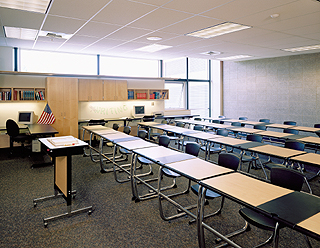|
Subscribe / Renew |
|
|
Contact Us |
|
| ► Subscribe to our Free Weekly Newsletter | |
| home | Welcome, sign in or click here to subscribe. | login |
Construction
| |
 |
August 31, 2006
State beefing up health and safety requirements
Integrus Architecture

Baibak
|
Just 10 years ago, health code reviews entailed a brief visit from the local health district at project sites. Officials made a quick tour, which typically revolved around restroom and kitchen inspections. The review was a formality.
Today, our increased awareness of health and safety issues in schools makes the process more complex. From the design and construction perspective, staying on top of the Washington Administrative Code and Washington Sustainable School Protocol as well as health and safety issues is a big job, and more important, critical to the success of each school project.
State guidance
The heightened awareness of health and safety issues has impacted schools, not only in their daily operations and programs, but also in their design and construction.
To provide a protocol for school inspections, the state Office of Superintendent of Public Instruction and the state Department of Health began publishing the Health and Safety Guide in 2000. The guide was developed by a committee of state education and public health officials who began working on the guide in 1996.

Photo courtesy of Integrus Architecture The state Health and Safety Guide includes a checklist to help designers and planners anticipate a school’s needs. Considerations such as appropriate lighting and acoustical controls figured into the design for this White River High School classroom in Buckley. |
Guidelines include both recommendations and required code laws. Health officials now use the second edition of the guide, published in 2003. A third, larger edition is in its draft phase.
Although the U.S. Environmental Protection Agency is the federal referral agency for health and safety issues, no records appear to track the movement of K-12 health and safety regulations nationwide.
Nancy Bernard, from state Department of Health, said tracking and sharing information with similar entities is difficult because states are structured differently.
“States regulate differently, and finding similar contacts is a challenge because regulations differ and even titles within states differ,” she said.
Bernard noted that safety and health regulations often are created as a result of an incident that might trigger a state response. As far as Washington’s position is concerned in the movement, Bernard thought the state “is ahead of the curve.” She said California is another state that has been proactive in providing guidance.
The checklist
| State Health and Safety Guide |
|
The 90-page guide is available online at http://www.k12.wa.us/SchFacilities/HealthSafetyGuide.aspx
|
The Health and Safety Guide includes a 35-page checklist that allows schools, health officials and others to review items in 19 health and safety categories. Categories run the gamut, covering items such as plumbing, lighting, sound control, indoor-air quality, science labs, bloodborne pathogens, athletics and performing arts.
Items within each category are identified as “recommended” or “required” by reference codes, including the Washington Administrative Code. In addition, the checklist indicates whether a plan review is required.
Each item to be inspected on the checklist receives a rating of either “satisfactory” or “unsatisfactory.” Within each category, items checked can be reviewed in existing facilities or can directly apply to the design and construction of school facilities.
Some checklist items are reviewed when construction documents are submitted for permitting, and some items need to be reviewed during a physical inspection of the facility and site. Even though Washington is the author of the guide and checklist, health department regulations are generally overseen by local jurisdictions.
This helpful checklist can be used in a variety of situations. School personnel are most familiar with inspections from county health officials when the school is full of children and in session.
Architects and engineers incorporate the checklist items during the development of the vision for a new facility and test interpretations of these guidelines during the permitting process. Although many architects and engineers have a working knowledge of the checklist, only recently has it been used as a standard component throughout the design process.
On the other end of spectrum, the Department of Health’s Bernard has encountered architects working school projects that are completely unaware of the checklist’s existence.
Advantages and costs
One purpose of the guide is to provide guidelines for designing high-quality learning environments.
For example, classrooms are expected to be designed to allow children with disabilities to hear their instructors. Mechanical systems are to be examined during design and tested after construction to minimize noise and ensure that airborne germs have been eliminated.
Soils are examined for toxins and wastewater pollutants. Lighting labs are used to ensure that rooms will satisfy sufficient-lighting requirements.
As a result, children today will learn in a safer, healthier environment than children of previous generations.
Being well acquainted with each district’s county health code will assist architects and districts hone their awareness of possible unforeseen requirements that can lead to unexpected costs on both major and minor school projects.
If those costs are overlooked, even for smaller projects, the results can be extremely expensive to remedy. For example, an elementary school near a freeway had planned to add portables to its existing site. The small budget on this project was overburdened when officials required a sound study.
Know your officials
Counties with fewer school projects face a steeper learning curve since working through the checklist items with a limited and inexperienced health department staff and can be time-consuming.
Jurisdictions with larger populations and more school projects under the belt often have health districts with more-developed processes for reviewing construction documents for permitting.
Unfortunately, jurisdictions with less experience with school projects can struggle to bridge the diversity of project types the health department code is attempting to address.
Architects and districts should first have an understanding of the health and safety checklist, but it’s also helpful to understand the local county health officials’ perspective and how the codes are interpreted.
For example, the placement of a restroom door near the school kitchen can be interpreted in a variety of ways. In one county, a door placement would fulfill all the requirements. In another, it may not meet county requirements.
Rebecca Baibak is a K-12 project manager for Integrus Architecture.
Other Stories:
- Getting around permitting hurdles takes creativity, teamwork
- Schools losing out as construction costs soar
- Flexible classrooms are a perfect fit
- Careful builders can avoid contract disputes
- Does your school building make the grade?
- Gateway opens up a closed-off campus
- Rain gardens: effective, natural and cheap
- Partnerships a high note for school, community


